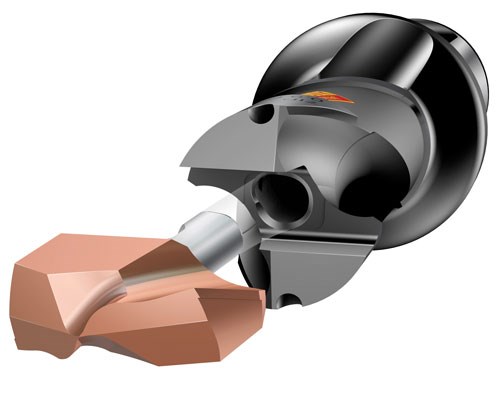Tips for Improved Holemaking
A few drill types dominate holemaking, a machining process made up of sub-areas that are evolving along with changing drill capabilities.
Cutting tool manufacturers face a constant challenge when raising performance levels of their products, including the important intermediate area of holemaking. But depending on their type, drills can vary substantially in their capabilities. They have established application areas according to hole requirements, practical limits to tooling and tool development. A few drill types dominate holemaking, a machining process made up of sub-areas that are evolving along with changing drill capabilities.
Frontrunners
Indexable insert drills provide unbeatable production economy, with high machining productivity for bolt-type holes as well as some thread-tapping holes. Drill-depth capability is 5× the diameter.
Solid carbide twist drills are ground and have the capability of making accurate holes with a high surface finish. However, they represent a relatively expensive tool even when reconditioning is considered.
Brazed carbide-tipped drills are ground and represent an intermediate diameter and tolerance area. Diameters typically range from 0.39 to 1.18 inch, with a depth capability of 5× the diameter. This type of drill can also be reconditioned, with a complex geometry requiring five-axis grinding.
Exchangeable-tip drills are a more recent development, shown to provide various benefits that have helped to establish a position in the market for this type of drill. In general, they provide tolerances in a range that falls between those of solid carbide drills and indexable insert drills, with some overlap. These drills offer benefits over brazed drills.
Holemaking Advancements
The intermediate area of holemaking has significant room for improvement. Holes of this type are found on a number of different components and materials formed by solid carbide and indexable insert drills. They can be deep holes, more precise fabrication holes, tubesheet holes in heat exchangers, fine holes made by reaming, and close-tolerance holes made for tapping. The technology of exchangeable tip drills can be limited both by its capabilities and the practical nature of the operation in terms of minimum and maximum sizes for acceptable tip design, but for the right area, it can provide an excellent solution.
To be most effective, the exchangeable-tip drill should have a tolerance capability of IT9 to IT11 and an Ra better than 2.5 micron, depending on the application. Hole-depth capability needs to be 12 times the diameter, with semi-standard options for shorter and intermediate lengths, further stability and depth options, and step and chamfer facilities. There needs to be a potential for relatively high penetration rates, the tool life of the tips needs to be long and consistent, and the tips need to be changed easily, quickly and in a foolproof way in the machine.
Improved Handling
The exchangeable-tip concept has been around for some years now, but potential weaknesses remain that are addressed in the development of new-generation drills. These concerns include strength and stability of interface, tool life, smooth cutting action, cutting data capability, degree of user friendliness, foolproof tip exchange, efficiency of chip evacuation, finishing consistency and machining reliability.
The CoroDrill 870, from Sandvik Coromant is a new-generation exchangeable-tip drill that provides improved machining economy to an important intermediate area of holemaking—the area usually determined by a specific combination of hole diameter, depth and quality requirements. The drill forms an integral part of the CoroDrill program and is positioned with the solid carbide CoroDrill 860 and indexable insert CoroDrill 880.
This drill concept has been developed to provide the necessary range with a more advantageous combination of penetration rates, tool life, finishing capability, reliability and tool handling. One of its advantages is the extent to which the tool can be tailored not only to suit, but also to optimize applications through diameter range and steps, length possibilities and shanks. Holes can be made more efficiently and closer to the specifications required, leaving holes better suited to subsequent operations.
The cutting edge geometry provides a safe cutting process with optimized chip control, high penetration rates and long, dependable tool life. The drill is available in a diameter range of 12 to 20.99 mm (0.472 inch to 0.826 inch) and lengths 3× and 5× hole diameter as standard.
Related Content
The Value of Tool Monitoring on Rotary Transfer Machines
By using a tool monitoring system, shops can save costs associated with machine maintenance and downtime for tool changes while increasing cutting performance.
Read MoreData Matrix Codes Offer Cutting Tool Traceability
A company’s quest to discover errors in a manufacturing process has led to printing data matrix codes on its cutting tools that provide a wealth of information for both the user and this cutting tool manufacturer.
Read MoreAutomation Breakthroughs Revolutionize Precision Machining for Complex Parts
Marubeni Citizen-Cincom delivers custom solutions to address some of the biggest challenges in precision machining from handling small parts, to robot integration and unique tooling needs.
Read MoreParting Off: The Case for Standardizing on Sawing
The value of rotary saw cutting for parting off operations could boil down to simple economics paired with process efficiency gains.
Read MoreRead Next
3 Threading Options for Holemaking
Thorough analysis before selecting and committing to tooling will produce quality holemaking in the most efficient and cost-effective way. Here's a look at three ways to cut threads.
Read More5 Aspects of PMTS I Appreciate
The three-day edition of the 2025 Precision Machining Technology Show kicks off at the start of April. I’ll be there, and here are some reasons why.
Read MoreA Tooling Workshop Worth a Visit
Marubeni Citizen-Cincom’s tooling and accessory workshop offers a chance to learn more about ancillary devices that can boost machining efficiency and capability.
Read More














.png;maxWidth=300;quality=90)








